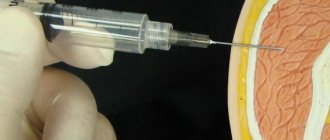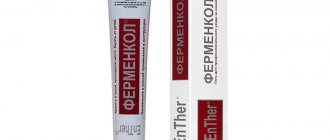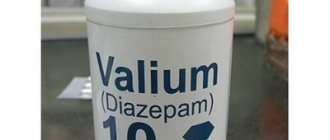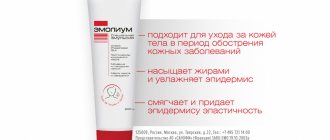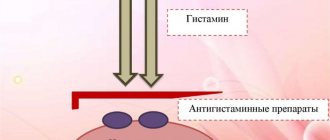Form of production
Papaverine is available in the form of tablets of 10 and 40 mg, rectal suppositories of 20 mg and a solution for injection of 20 mg in one ampoule.
The tablets have a white or yellowish tint. They are odorless, have a bitter taste, and have two perpendicular marks. For adults, the drug is available in a dosage of 40 mg, for children – 10 mg. Packed in blisters of 10 pieces. The cardboard package contains 2 blisters.
The suppositories are produced in a torpedo-shaped form for insertion into the rectum, have a white tint, and are odorless. Dosage – 20 mg. One blister contains 10 suppositories. The cardboard package includes one blister and an insert – Papaverine’s instructions.
Papaverine solution is transparent, odorless, available in ampoules of 20 mg. Cardboard packaging includes 10 ampoules.
Compound
The composition of Papaverine depends on the form of release of the drug. In all cases, the medicine contains one active component - papaverine hydrochloride. Tablets, injection solution and suppositories include various auxiliary components. The exact information can be found in the table.
Chemical composition of various forms of Papaverine
The pharmacological group of the drug is myotropic antispasmodics, vasodilators.
International nonproprietary name (INN) – Papaverine, Papaverine (English), Papaverinum (Latin).
Papaverine ointment
Papaverine ointment is a separate medication group. The product contains an active component - papaverine hydrochloride and auxiliary components - purified water, lanolin, sunflower oil.
Indications for use:
- conditions associated with intestinal spasms;
- spastic constipation;
- haemorrhoids;
- anal spasm;
- spasms caused by diseases of the genitourinary system.
Papaverine cream is applied to the perineum and anus to reduce pain. It is recommended to do this after carrying out hygiene procedures 2–3 times a day. If the patient uses other ointments and gels, be sure to inform the doctor about this.
Generics
Papaverine medications are very popular among patients. This is due to the increased safety and cost of the drug. But there are no medications in the form of ointments, except for Papaverine. As substitutes, you can purchase tablets or suppositories.
The ointment should be kept in its original packaging in a cool and dark place away from children. The shelf life is 2 years. The drug is dispensed without a prescription from a specialist.
Pharmacological properties
The drug papaverine has a good antispasmodic and moderate analgesic effect. Due to its ability to relieve spasm from the smooth muscles of internal organs and blood vessels, the medicine has a mild hypotensive effect. This makes it possible to use it in the initial stages of hypertension and in some other conditions characterized by increased blood pressure.
Once in the body, the active component papaverine hydrochloride inhibits the activity of phosphodiesterase enzymes, which leads to a decrease in calcium concentration in cells. This process contributes to disruption of the contractile function of smooth muscles, consequently, muscle relaxation, elimination of spasm and pain.
The medicine Papaverine is used for diseases of the respiratory, digestive, cardiovascular systems, and for diseases of the kidneys, liver, gall bladder and other organs.
Important! Despite Papaverine’s ability to relax the smooth muscles of the muscles, a person’s motor activity is completely preserved.
Indications
The medicine can be used as an independent remedy or along with other medications and helps get rid of:
- spasms of smooth muscles (most often with spastic colitis, cholecystitis, pylorospasm);
- serious condition due to excessive increase in blood pressure;
- endarteritis and other spasms of peripheral vessels;
- acute pain syndrome in the kidneys due to impaired urine outflow due to impaired patency of the upper urinary tract;
- bronchospasms;
- angina pectoris;
- spasms of blood vessels in the brain;
- difficulty in urinating or its absence due to spasms in the urinary tract;
- hemorrhoids, large hemorrhoids (in this case it is advisable to resort to rectal suppositories);
- high temperature;
- impotence.
Often, relaxation of smooth muscles before urological or proctological operations, as well as manipulations in the abdominal cavity, is achieved using Papaverine injections
Pharmacokinetics
The active substance, entering the body, is quickly absorbed, regardless of the form of release of the drug. Communication with blood proteins is up to 90%. The drug is metabolized in the liver. The approximate half-life of Papaverine ranges from half an hour to 120 minutes. Active and auxiliary components are excreted from the body by the kidneys in the form of metabolites.
The effect of the medicine is observed after 15 – 20 minutes
For hemorrhoids
For varicose veins in the venous plexuses of the rectum, papaverine ointment is included in the structure of complex treatment. The medication has analgesic, as well as antispasmodic and sedative effects.
The ointment is often used to eliminate enlarged hemorrhoids. The product is easy to use and dries quickly. The positive effect occurs 15-20 minutes after application. The person feels that pain, as well as itching and burning begin to disappear.
Ointment with papaverine is prescribed for spastic constipation. The medicine is used for stenosis in the urethra. According to the instructions for use, papaverine ointment is indicated for application when there is a painful feeling in the veins.
For chronic varicose veins of the venous plexuses of the rectum, the ointment acts as a sedative. The structure contains substances that help prevent constipation of spastic origin.
In addition, lanolin ointment is used for hemorrhoids. It can be applied to veins, which helps to dilate blood vessels and improve blood flow. The drug is often used to relieve pain from hemorrhoids. But in such situations, rectal suppositories are recommended for use, which go deep into the rectum and dissolve there.
But the medication can be used for enlarged external hemorrhoids. After applying Papaverine, pain and discomfort are eliminated. Blood flow in the veins is resumed, causing the nodes to decrease in size.
Before using the medication, you should wash the sphincter area with soap and water. The ointment can be used for enlarged external hemorrhoids. After applying the medicine to the affected area, the patient should rest for 10-15 minutes.
When to use the product
What is Papaverine used for? The medicine is used orally, rectally, intravenously or intramuscularly for various diseases that cause spasm of the smooth muscles of the body.
Indications for use of Papaverine are as follows:
- diseases of the abdominal organs (cholecystitis, spastic colitis, pancreatitis, etc.);
- as a complex treatment for relieving hypertensive crisis;
- violation of urine discharge from the kidneys;
- spasms of peripheral veins;
- conditions associated with contraction of cerebral vessels;
- to relieve angina attacks;
- respiratory dysfunction;
- narrowing of the renal arteries;
- narrowing of the urinary tract caused by spasm, causing urinary retention.
Papaverine should be taken strictly according to a doctor’s prescription, despite its wide spectrum of action and apparent safety. Improper use of the drug often provokes many side effects.
To whom the product is prohibited
Instructions for use of Papaverine include absolute and relative contraindications to the use of the medicine.
Absolute:
- individual sensitivity of the patient to the active and auxiliary substances of the drug;
- heart diseases associated with its conduction (blockades);
- acute kidney pathologies, renal failure;
- liver pathologies;
- glaucoma;
- age of patients after 65 years, which is associated with an increased risk of developing hypertension);
- children's age: injections/tablets/suppositories – 6 months/14 years/18 years.
When prescribing a drug, its contraindications must be taken into account.
Relative:
- recent traumatic brain injury;
- chronic renal failure;
- anaphylactic shock;
- vascular collapse;
- dysfunction of the adrenal cortex.
Important! The decision on the advisability of prescribing a drug in the presence of relative contraindications is made by the leading specialist, assessing the balance of benefit and risk in a particular case.
Contraindications
The drug is not used in the following cases:
- in case of individual intolerance or hypersensitivity to the ingredients of the drug;
- disruption of the transmission of nerve impulses in the conduction system of the heart (atrioventricular block);
- severe liver failure;
- glaucoma;
- comatose states;
- depressed breathing;
- bronchial obstruction;
- low blood pressure.
Papaverine is not used in childhood until the child is one year old and in elderly people due to the risk of increased body temperature
The use of the drug is possible only under the supervision of an experienced specialist due to the following reasons:
- recent intracranial injuries;
- chronic pathological changes in the kidneys;
- lack of thyroid hormones (thyroid hormones) in the body;
- shock;
- an increase in the number of benign pancreatic cells;
- arrhythmia caused by disruption of electrical conductivity and regulation of heart rate;
- adrenal insufficiency.
In addition, the use of papaverine in combination with monoamine oxidase inhibitors is prohibited.
Side effects
Papaverine in tablets, injections and when using rectal suppositories can cause side effects. More often this is due to non-compliance with the dosage prescribed by the doctor or self-medication with the drug.
Undesirable consequences:
- pathological decrease in blood pressure;
- heart blocks;
- increased sweating;
- nausea;
- constipation;
- yellow tint to the dermis and eyeballs;
- irritability, drowsiness;
- fatigue, loss of ability to work;
- when using the drug intravenously, vein thrombosis is possible;
- blood composition disorder;
- allergic skin rashes.
If the described symptoms appear, you must immediately stop taking the medication and seek medical help. Treatment is usually carried out by normalizing blood pressure and removing excess drugs from the body.
Adverse reactions
The drug is well tolerated by patients, but in some cases, with increased individual sensitivity or exceeding the dose after the injection, side effects may develop:
- Dizziness;
- Constipation;
- Bloating;
- Lethargy, drowsiness;
- Decrease in blood pressure;
- Increased sweating;
- Liver dysfunction, increased activity of organ transminases.
After discontinuing the drug or reducing the dose, all negative reactions disappear.
Directions for use and doses
Let's look at how to take Papaverine. For children and adults, the dosage is selected individually depending on the characteristics of the course of the disease.
The dosage and regimen are selected exclusively by the doctor.
The dosage of tablets for an adult is usually 40 – 60 mg. Papaverine is prescribed to children in accordance with the characteristics of the disease, age and weight of the patient.
Suppositories are prescribed in 1 - 3 pieces (20 - 60 mg) for adult patients. Until the age of 14, the drug is used with extreme caution only if necessary.
Papaverine solution is administered intravenously very slowly, exclusively by a medical professional. The contents of one ampoule are diluted with 20 ml of sodium chloride. Intramuscular injections of Papaverine are prescribed to patients at 40–60 mg per day.
Dosage
The excellent bioavailability of the drug allows the use of intramuscular, subcutaneous or intravenous injections without loss of its therapeutic abilities.
To avoid hematomas, a subcutaneous injection is given on the outer thighs or in the shoulder. An intramuscular injection is given in the outer upper quadrant of the buttock
Treatment with papaverine can continue for a long time, as prescribed by the attending physician, and is completed as the painful condition is eliminated.
Before administering a pharmaceutical drug intravenously, it is diluted with saline solution (NaCl) in an amount of 10–20 ml. To avoid discomfort in the patient, papaverine is administered slowly.
Intramuscular and intravenous injections involve the use of the following dosages:
- for the adult category of the population – one-time – 0.1 g, per day – 0.3 g;
- from six months to a year - one-time - 0.005 g, per day - 0.01 g;
- 2–3 years – one-time – 0.01 g, per day – 0.02 g;
- from 3 to 4 years – one-time – 0.015 g, per day – 0.03 g;
- from 5 to 6 years – one-time – 0.02 g, per day – 0.04 g;
- from 7 to 9 years – one-time – 0.03 g, per day – 0.06 g;
- from 10 to 14 years – one-time – 0.06 g, per day – 0.1–0.2 g.
It should be taken into account that the interval between intravenous injections should be at least 4 hours.
When administered subcutaneously, the dosage of the drug is usually 1 ampoule.
An overdose of the drug can lead to general malaise, diplopia, increased sweating, headaches and arrhythmia.
These symptoms can be eliminated with symptomatic therapy and gastric lavage.
Use during pregnancy
Despite the fact that one of the contraindications of Papaverine is the period of pregnancy and lactation, the drug is still prescribed to women bearing a child.
Many mothers face such a problem as increasing the tone of the uterus. This condition brings a lot of unpleasant sensations, in addition, it poses a threat of premature birth. To relax the muscles of the reproductive organ, Papaverine tablets or suppositories are often used. In a hospital setting, injections can be used.
Papaverine is used to prepare the cervix before childbirth. The drug is used in combination with No-Spa and other agents. Throughout the day, the woman is administered one suppository of each drug.
When breastfeeding, the use of Papaverine is contraindicated, since the active component of the drug passes into the mother's milk and therefore reaches the baby. If there is a need to use medication, stop feeding the baby.
special instructions
During therapy with the medication, you should avoid drinking alcohol. The active components of the product in combination with alcohol can cause a negative reaction.
Papaverine often has positive reviews, but despite this, the medicine should be used only as prescribed by a doctor.
The drug of any release form is used with extreme caution among patients with severe pathologies of the kidneys and liver.
Alcoholic beverages should be avoided during treatment with Papaverine.
When administered intravenously, the injection is given slowly and under the supervision of a doctor. Too rapid administration can cause heart rhythm disturbances and other negative consequences.
Among patients who have suffered skull injuries, the medicine is used only if necessary in a hospital setting.
Analogs
The drug has many analogues that have similar therapeutic effects and indications.
Papaverine analogues included in the electronic list of drugs (RLS) are as follows:
- Platyphylline with papaverine - has an antispasmodic, vasodilating effect. The drug is used for diseases of the abdominal organs, to eliminate spasms of cerebral vessels, for angina pectoris, endarteritis, bronchospasms and other pathologies;
- Papaverine bufus is an antispasmodic medication that causes dilation of large and small vessels, restoring blood flow. The medicine has a hypotensive, moderate analgesic effect;
- No-Shpa forte is a drug that is produced in the form of tablets and solution for injection. The product has a vasodilator, antispasmodic, and moderate analgesic effect;
- Spazmolysin suppositories - used to eliminate pain caused by spasms of smooth muscles in diseases of the respiratory, cardiovascular, and digestive systems;
- Spazmobrew tablets are a product based on hyoscine butylbromide, which has an antispasmodic effect. It is used to treat spasms of the gastrointestinal tract, to prevent nausea and vomiting in patients who have undergone surgery, to coordinate the birth process in women with renal colic and other conditions.
The description of the products is for informational purposes only; exact information should be clarified from the instructions for use of the medicine or from the attending physician.
Arterial pressure
The combination of dibazole with papaverine normalizes blood pressure and eliminates the unpleasant symptoms of its increase.
The combined use of two drugs has a better medicinal effect than each drug separately, due to the ability to enhance the therapeutic effect of each other
The dosage should be calculated by the doctor depending on the general condition of the patient, as well as his blood and pulse pressure. As a rule, Papaverine 2 ml and Dibazol 4 ml are used.
In case of critical condition of the patient, Analgin is added to the above drugs to enhance the analgesic effect.
At the moment, there is a combined dosage form of Papaverine and Dibazol - Papazol. This drug is available in tablets and has vasodilating and antispasmodic effects.
Today, the pharmaceutical industry offers numerous medications for high blood pressure. But Dibazol and Papaverine do not lose their popularity due to their relative safety, good effectiveness and rare occurrence of side effects.
The drugs are administered intramuscularly and:
- eliminate vascular spasms in the brain;
- dilate blood vessels;
- relieve pain associated with high blood pressure and normalize its levels;
- minimize the risk of hypertensive crisis.
A universal remedy for lowering blood pressure is triad containing:
- analgin (50% solution, 2 ml);
- papaverine (2% solution, 2 ml);
- diphenhydramine (1% solution, 1 ml).
Triad injections also have an antipyretic effect, but in any case their use must be approved by the attending physician.
Patient reviews
Valery, Taganrog “Papaverine is always in our medicine cabinet. Of course, my wife and I don’t take pills constantly and uncontrollably, but in some cases they really do help, especially since we both suffer from periodic high blood pressure. The drug is good, it’s inexpensive, I’m satisfied with its effect.”
Natalya, Kazan “When the weather changes, I always suffer from headaches. This is due to vasospasm. The doctor recommended that I take a Papaverine tablet. The product helps well, after 15-20 minutes I feel relief.”
Victor, Ivanovo “Several years ago I was diagnosed with urolithiasis. I was in the hospital where they crushed stones for me. Now fine sand is still coming out little by little. In this case, the pain is quite severe. To alleviate the condition, the doctor prescribed me Papaverine. The drug does its job perfectly, the pain goes away within a quarter of an hour.”
